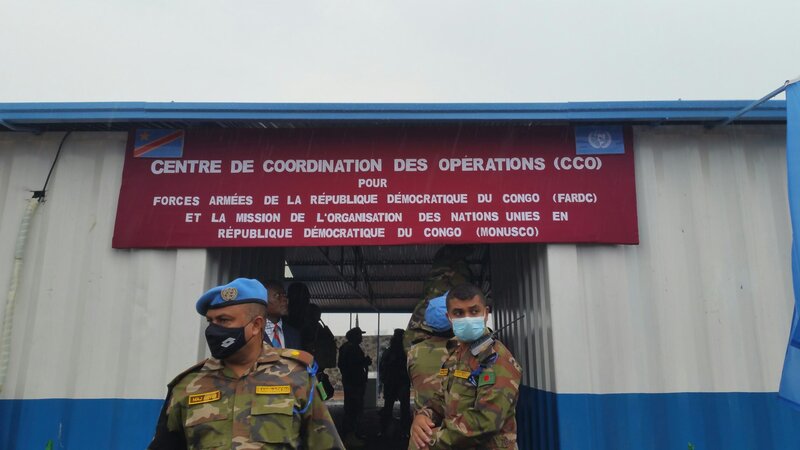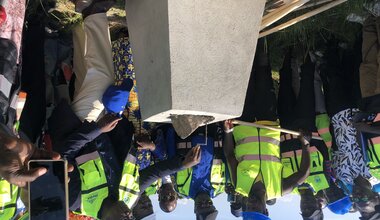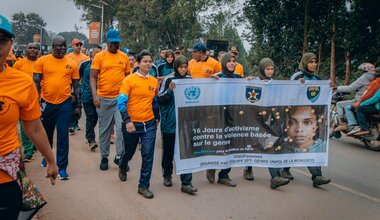Jean-Pierre Lacroix Applauds the Good Cooperation Between MONUSCO and the North-Kivu provincial Authorities, in Goma
In Goma, the second leg of his three-day visit to the DRC, the United Nations Under-Secretary-General for Peace Operations held a working session on February 23 with the DRC Minister of Defense, Gilbert Kabanda; in attendance: the provincial military Governor, General Constant Ndima, MONUSCO delegation, including the Special Representative of the UN Secretary General Ms. Bintou Keita and the Deputy Special Representative for operations, Khassim Diagne, as well as the heads of the Petit Nord and Grand Nord offices.
Their discussions focused not only on the latest developments marked by violence and killings against civilian populations, but also on the targeted attacks against the internally displaced persons’ camp in Ituri. In his first statement to the local media at Goma airport, coming from Bunia, the Under-Secretary-General applauded the good cooperation between the United Nations and the Congolese authorities.
In the North Kivu, Jean-Pierre Lacroix said, "A very active work is being carried out here, more particularly in terms of the security response, with the help of the good coordination established with the FARDC, the latter having a neighboring partner who works with them. I believe this common determination is bearing fruit. We are all realistic, this takes time.’’
While acknowledging that stabilization efforts take time, Mr. Lacroix reaffirmed the UN commitment to support the Congolese government. "We reaffirm our support on a regular basis, our commitment to remain determined and at the same time we acknowledge that such problems cannot be solved in a few weeks or a few months," he said.
5.6 Million Internally Displaced Persons in DRC
During his meeting with the media early this Wednesday morning at the Serena hotel, Jean-Pierre Lacroix raised again the unacceptable attacks perpetrated on the internally displaced persons’ camp in Ituri. In view of this situation, He has called for a maximum use of the civilian and military human potentials to protect the civilian populations.
For her part, the Special Representative of the UN Secretary General in the DRC, Ms. Bintou Keita, disclosed that, to date, there are a little over 5.6 million internally displaced persons in the DRC. The head of MONUSCO deplores the flare-up of gender-based sexual violence in all those internally displaced camps.
Finally, MONUSCO Force Commander, General Affonso Da Costa gave an update on the means used in the Mission’s response during the operations carried out in the three provinces in the grip of continued violence and which cover an area of more than 200 000 km2.
Despite the non-existence of roads and sometimes extremely difficult conditions, mobile troops have been set up in Ituri to track down the CODECO movement and at the same time to protect the civilian population. For the Force Commander, the response in this conflict should not only be military; A civilian response, through the involvement of all the communities, can help bring peace in the DRC.
Anticipating Threats
In conclusion, Jean-Pierre Lacroix insisted on the need to anticipate threats, to always have the capacity to intervene with the necessary means available and above all to work in an integrated manner, more particularly with the specialized agencies, humanitarian actors, civilian components and MONUSCO troops.
Before wrapping up his visit to Goma, the United Nations Under-Secretary-General visited the Operations Coordination Center (OCC) which brings together FARDC, PNC and MONUSCO peacekeepers. Established on February 18, 2022, this new mechanism is based at Goma International Airport.
The mechanism pursues several goals:
• To coordinate the joint operations (MONUSCO/FARDC) aimed at stopping or limiting armed groups’ attacks;
• To develop a better common understanding of the situation;
• To jointly plan operations;
• To have information shared in a timely manner between the Mission’s Force and the FARDC;
• To facilitate decision-making that would lead to the fulfillment of the mandate assigned to MONUSCO.
The area of action for this new mechanism covers the Congolese national territory, more particularly all the areas of intervention under the FARDC and where MONUSCO peacekeepers are deployed, in particular the Northern, the Central and the Southern sectors, as well as the Rapid Intervention Brigade.

 UN
UN United Nations Peacekeeping
United Nations Peacekeeping






